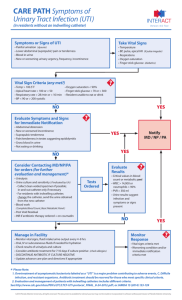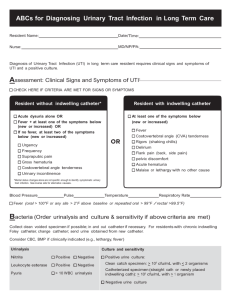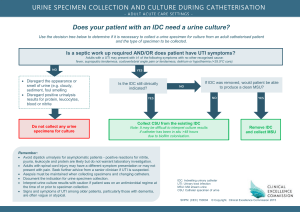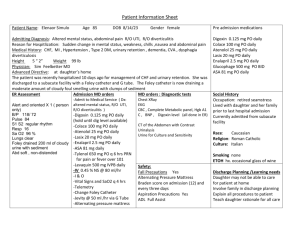Urinary Tract Infections
advertisement
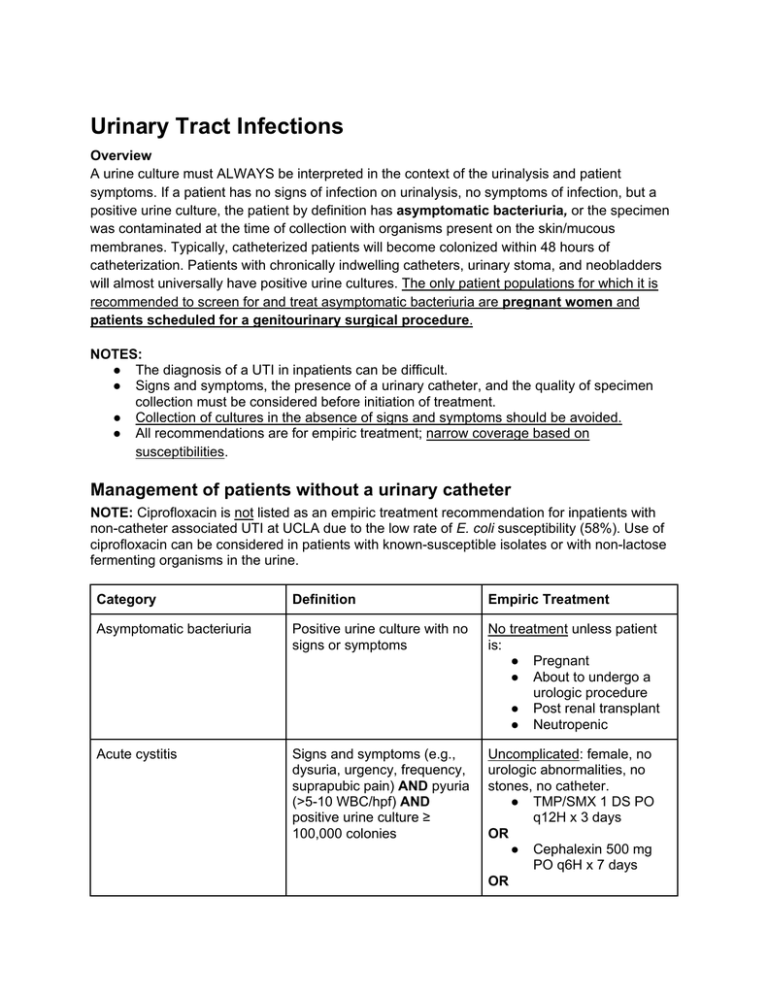
Urinary Tract Infections Overview A urine culture must ALWAYS be interpreted in the context of the urinalysis and patient symptoms. If a patient has no signs of infection on urinalysis, no symptoms of infection, but a positive urine culture, the patient by definition has asymptomatic bacteriuria, or the specimen was contaminated at the time of collection with organisms present on the skin/mucous membranes. Typically, catheterized patients will become colonized within 48 hours of catheterization. Patients with chronically indwelling catheters, urinary stoma, and neobladders will almost universally have positive urine cultures. The only patient populations for which it is recommended to screen for and treat asymptomatic bacteriuria are pregnant women and patients scheduled for a genitourinary surgical procedure. NOTES: ● The diagnosis of a UTI in inpatients can be difficult. ● Signs and symptoms, the presence of a urinary catheter, and the quality of specimen collection must be considered before initiation of treatment. ● Collection of cultures in the absence of signs and symptoms should be avoided. ● All recommendations are for empiric treatment; narrow coverage based on susceptibilities. Management of patients without a urinary catheter NOTE: Ciprofloxacin is not listed as an empiric treatment recommendation for inpatients with non-catheter associated UTI at UCLA due to the low rate of E. coli susceptibility (58%). Use of ciprofloxacin can be considered in patients with known-susceptible isolates or with non-lactose fermenting organisms in the urine. Category Definition Empiric Treatment Asymptomatic bacteriuria Positive urine culture with no signs or symptoms No treatment unless patient is: ● Pregnant ● About to undergo a urologic procedure ● Post renal transplant ● Neutropenic Acute cystitis Signs and symptoms (e.g., dysuria, urgency, frequency, suprapubic pain) AND pyuria (>5-10 WBC/hpf) AND positive urine culture ≥ 100,000 colonies Uncomplicated: female, no urologic abnormalities, no stones, no catheter. ● TMP/SMX 1 DS PO q12H x 3 days OR ● Cephalexin 500 mg PO q6H x 7 days OR ● Nitrofurantoin 100 mg PO q12H x 5 days (do NOT use in patients with CrCl < 40 ml/min) Complicated: male, stones, urologic abnormality, pregnancy. ● Same regimens as above, except duration is 7-14 days. Acute pyelonephritis Signs and symptoms (e.g., fever, flank pain) AND pyuria AND positive urine culture ≥ 100,000 colonies. Many patients will have other evidence of upper tract disease (i.e., leukocytosis, WBC casts, or abnormalities on imaging). Urosepsis Patient not severely ill ● Ertapenem 1 g IV q24H OR ● Ceftriaxone 1 g IV q24H Duration 7-14 days Patient severely ill or hospitalized >48 hours ● Meropenem 1 g IV q8H OR ● Cefepime 1 g IV q8H OR ● PCN allergy: Aztreonam 1 g IV q8H Duration 7-14 days SIRS due to urinary tract infection ● Meropenem 1 g IV q8H ● Cefepime 1 g IV q8H OR OR ● PCN allergy: Aztreonam 1 g IV q8H Duration 7-14 days DIAGNOSIS Specimen collection: The uretheral area should be cleaned with an antiseptic cloth and the urine sample should be collected midstream or obtained by fresh catheterization. Specimens collected using a drainage bag or taken from a collection hat are not reliable and should not be sent. Interpretation of the urinalysis (U/A) and urine culture ● Urinalysis and urine cultures must be interpreted together in context of symptoms. ● Urinalysis/microscopy: ○ Dipstick ○ ● ■Nitrites indicate bacteria in the urine indicates the presence of a nitratereducing microorganism, such as Escherichia coli or any other member of the Enterobacteriaceae family. ■Leukocyte esterase indicates white blood cells in the urine ■Bacteria: presence of bacteria on urinalysis should be interpreted with caution and is not generally useful Pyuria (more sensitive than leukocyte esterase): >5-10 WBC/hpf or >27 WBC/microliter Urine cultures: ○ If U/A is negative for pyuria, positive cultures are likely contamination. ○ Positive cultures with pyuria are defined as ≥ 100,000 (105) colonies. This cutoff is the most sensitive for a true UTI. Situations in which lower colony counts <105 are significant include: patients who are already on antibiotics at the time of culture, symptomatic young women, suprapubic aspiration, and men with pyuria. TREATMENT NOTES ● Sterile pyuria (positive U/A, but negative culture results) typically requires no treatment, although if the patient has received antibiotics, the patient may still have a UTI. If sterile pyuria persists consider other causes (e.g., interstitial nephritis or cystitis, fastidious organisms such as TB). ● Follow-up urine cultures or U/A are only warranted for ongoing symptoms. They should NOT be acquired routinely to monitor response to therapy. ● See below for discussion of treatment options for VRE and renal concentrations of antibiotics. Management of patients WITH a urinary catheter Category Definition Empiric Treatment Asymptomatic bacteriuria Positive urine culture with no signs or symptoms of infection. Remove the catheter NOTE: obtaining routine cultures in asymptomatic patients is not recommended No treatment unless the patient is: ● Pregnant ● About to undergo a urologic procedure ● Post renal transplant ● Neutropenic Antibiotics do NOT decrease asymptomatic bacteriuria or prevent subsequent development of UTI Catheter-associated UTI (CAUTI) Signs and symptoms (fever with no other source is the ● Remove (PREFERRED) or most common; patients may also have suprapubic or flank pain) AND pyuria (>5-10 WBC/hpf) AND positive urine culture ≥ 100,000 colonies (see information below regarding significant colony counts) replace catheter in all patients Patient stable with no evidence of upper tract disease: ● If catheter removed, consider observation alone OR ● Ertapenem 1 g IV q24H OR ● Ceftriaxone 1 g IV q24H OR ● Ciprofloxacin 500 mg PO BID or 400 mg IV q12H (avoid in pregnancy and in patients with prior exposure to quinolones) Duration: see treatment notes Patient severely ill, with evidence of upper tract disease, or hospitalized >48 H: ● Meropenem 1 g IV q8H OR ● Cefepime 1 g IV q8H OR ● PCN allergy: Aztreonam 1 g IV q8H Duration: 7-14 days DIAGNOSIS Specimen collection: urine sample should be drawn in a sterile fashion from a fresh catheter specimen. It should be drawn from either the catheter itself or through the port designed specifically for this purpose, NOT from the urine collection bag. Specimen collection is critical since colonization of the Foley bag or actual catheter is common. Symptoms: Catheterized patients often lack typical symptoms of dysuria, although fever, suprapubic pain, and flank pain may still be present. Interpretation of the urinalysis and urine culture: ● ● Pyuria: defined as >5-10 WBC/hpf or >27 WBC/microliter. In the presence of a catheter, pyuria or positive cultures are not always a reliable indicator of infection. Lack of pyuria suggests no active infection. Positive urine culture: ≥100,000 colonies is the most specific for true CAUTI. Some experts state that ≥1,000 colonies represents significant bacteriuria; however, if this count is used, there should be a strong clinical suspicion of CAUTI based on symptoms and absence of infection at another site. TREATMENT NOTES ● Remove catheter whenever possible. ● The duration of treatment has not been well-studied for CAUTI. ● Assess the degree of illness, comorbidities, and clinical response to determine duration of therapy. As a general guide: ○ If the catheter is removed and the patient is not severely ill and has good response to treatment: 5-7 days. ○ If the catheter remains present or the patient is severely ill (e.g. urosepsis) or has pyelonephritis: 7-14 days. Treament of UTI due to Enterococci ● Almost all E. faecalis isolates are susceptible to Amoxicillin 500 mg PO TID OR Ampicillin 1 g IV q6H and should be treated with these agents. For patients with PCN allergy: Nitrofurantoin 100 mg PO BID (do NOT use in patients with CrCl < 40 mL/min). ● E. faecium (commonly vancomycin resistant) ○ Nitrofurantoin 100 mg PO BID if susceptible (do NOT use in patients with CrCl < 40 mL/min) ○ Doxycycline 100 mg PO BID if susceptible ○ Fosfomycin 3 g PO once (if female without catheter or catheter is removed; ask the micro lab for susceptibility) ○ Linezolid 600 mg PO BID OR fosfomycin 3 g PO every 2-3 days (max 21 days) if complicated UTI or catheter cannot be removed Treatment of UTI due to extended spectrum beta-lactamase (ESBL)-producing organisms ● ESBLs are enzymes that confer resistance to ALL penicillins, cephalosporins, and aztreonam. ● Risk factors for infection or colonization: recent hospitalization, residence in a long-term care facility, prolonged use of broad spectrum antibiotics. ● Meropenem 1 g IV q8H should be used for all severe urinary infections if the organism is susceptible. ● Ertapenem 1 g IV q24H can be used for uncomplicated UTI. ● Ciprofloxacin or TMP/SMX can be used as alternatives to ertapenem for uncomplicated UTI if the organism is susceptible. Nitrofurantoin or fosfomycin may also be used for uncomplicated UTI if the organism is suceptible. Renal excretion/concentration of selected antibiotics ● Good (>60%): aminoglycosides, amoxicillin, amoxicillin/clavulanate, fosfomycin, cefazolin, cefepime, cephalexin, ciprofloxacin, colistin, ertapenem, levofloxacin, trimethroprim/sulfamethoxazole, vancomycin, amphotericin B, fluconazole, flucytosine ● Variable (30-60%): cefpodoxime, linezolid (30%), doxycycline (29-55%), ceftriaxone, tetracycline (~60%) ● Poor (<30%): azithromycin, clindamycin, oxacillin, tigecycline, caspofungin, posaconazole, voriconazole References: Pyuria and urinary catheters: Arch Int Med 2000;160(5):673-77. IDSA Guidelines for treatment of uncomplicated acute bacterial cystitis and pyelonephritis in women: Clin Infect Dis 1999;29:745. European and Asian guidelines on management and prevention of CA-UTI: Int J Antimicrob Agents 2008; 31S:S68.
